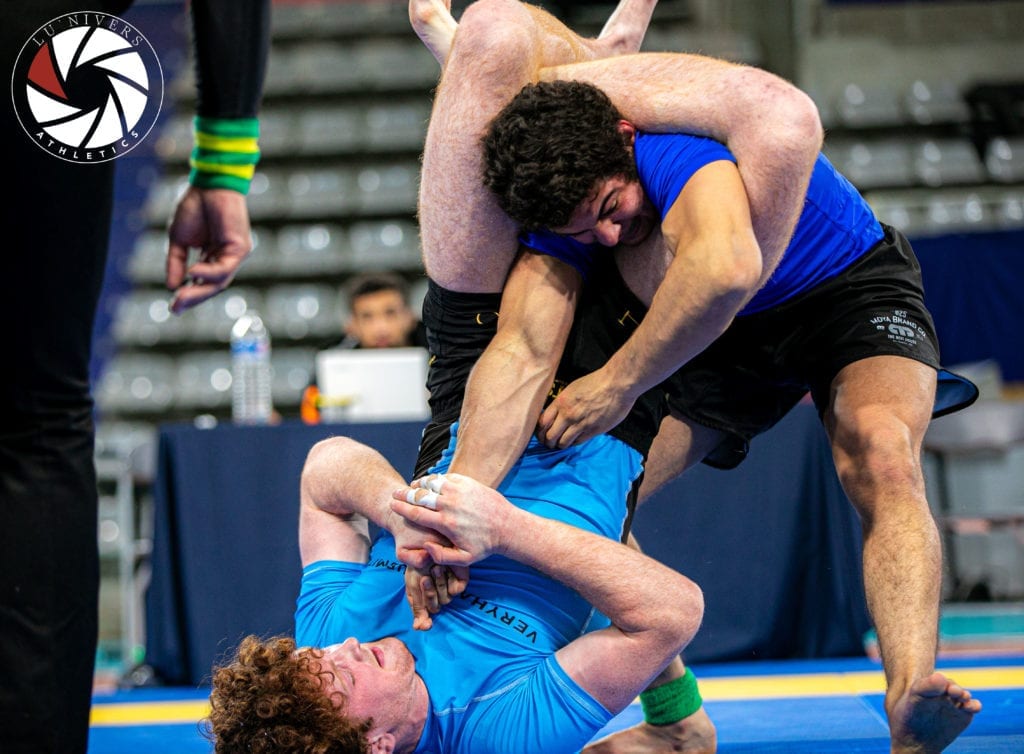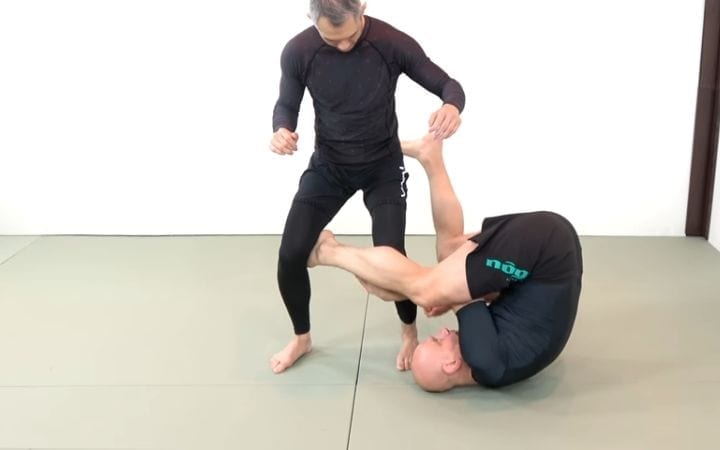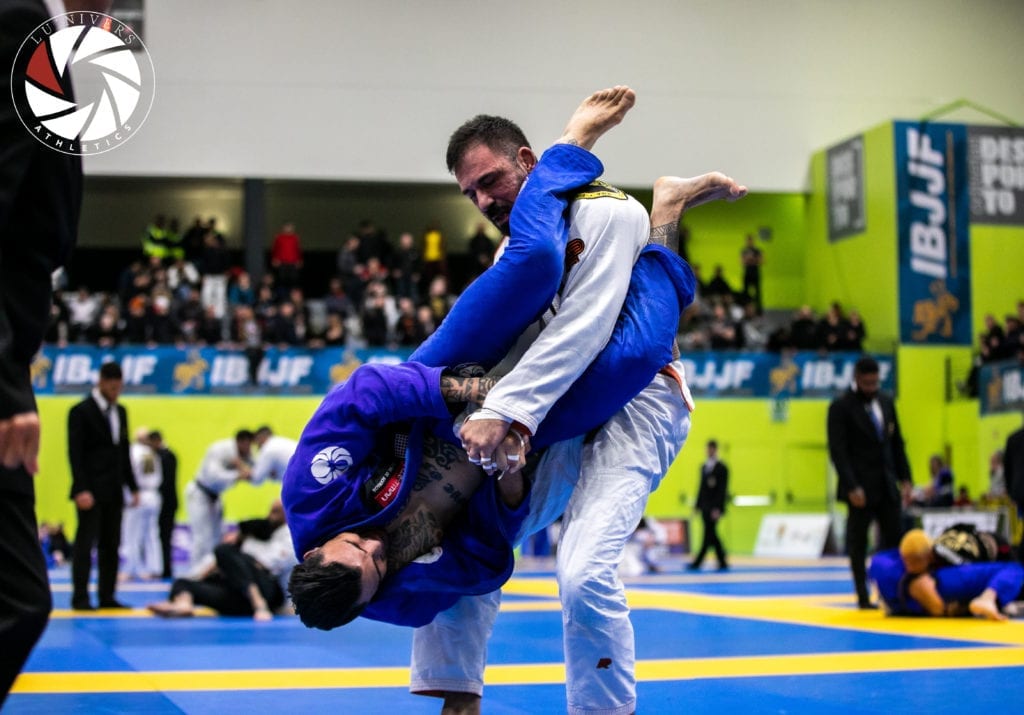If you’ve trained BJJ for more than a month, then you’ve probably checked out at least one flashy Jiu Jitu technique on YouTube. Though many moves are more theatrical than practical, some unorthodox BJJ moves are quite useful. Understanding why and when to use these moves is as important as knowing how to execute them.
Stick To The Basics…But Not Always
Jiu Jitsu is strategic. It is valuable to learn when to stick to basic BJJ moves and when you can rely on flashy ones. Basics are the foundation of flashy moves. Build a good arsenal of basic techniques so that you will eventually be able to branch out to more complicated moves.
Flashy moves will most likely not be your go-to techniques. You must execute them quickly to be effective; they are meant to be done with speed and precision to get you to your goal, whether it be a submission, a dominant position, or to escape a bad situation.

Image Credit to www.luniversproduction.com/Flashy moves are beneficial in a competition where your main goal is a quick finish. Sometimes by using a flashy move, such as a flying armbar, you can end your match in under a minute.
You can also use these moves to win a match if you’re down on points. If you’re losing a match by points and time is running out, this can be the perfect time to try a flashy move that could get you a surprise victory by submission.
5 Flashy BJJ Moves That Will Actually Work
Imanari Roll
The Imanari roll, created by MMA legend Masakazu Imanari, is a leg lock entry that utilizes leg entanglement for limb control. It’s a complex move that is quick and effective.
The basis for the Imanari roll is a sideways roll. It’s helpful to drill these rolls along with berimbolo drills with a partner before attempting the Imanari roll.

The Imanari roll begins in a standing position where you fake a takedown with a penetration step. The penetration step is the most crucial part of the set-up. If you don’t take a big enough step, you won’t be close enough to your opponent to complete the move.
Once you take your penetration step, fall into a sideways roll. As you roll, use your hand to grab behind your opponent’s knee to pull yourself into them. Hook your inside leg inside your opponent’s legs and swing your outside leg around to hook it behind both legs. Make sure both of your legs end up behind your opponent’s far leg.
The momentum of this move will take your opponent down, and should leave you in a position where his/her leg is across your body, ready for a heel hook, straight ankle lock, or kneebar.
Flying Armbar
The flying armbar is a great way to attack your opponent. But, you must understand the mechanics of a basic armbar before you can apply this move effectively.
As with a normal armbar, you want substantial control of your opponent’s elbow and wrist before you attempt to launch yourself. You don’t want to land in a position where your hips are below the elbow. Lose the elbow, lose the submission.
Start with a grip behind the elbow (around the bicep for no gi) and either a lapel grip or collar tie. If you’re using the gi, grab the material behind the elbow and then twist it inward for a tight, solid anchor.
Your take-off should be without hesitation. Hesitate, and you miss the move
When you launch yourself, first launch off your foot that’s on the same side as your collar//head grip and place your leg on your opponent’s hip.
Your landing should put you in an excellent position to finish the armbar quickly. Simply whip your other leg up and across your opponent’s face/neck for the finish.
Tornado Guard
Tornado guard is an inverted guard position popularized by BJJ World Champion Robert “Cyborg” Abreu. The tornado guard’s foundation is half guard, where you always have one leg between your opponent’s legs. This creates the leverage you need to manipulate them into a sweep.
To perform the tornado guard, start in a standard half guard position, creating a frame with a cross collar grip with your outside arm.
Using your inside arm, get a grip on your opponent’s trapped leg and then place your outside leg across his opposite shoulder while inverting. Keep your inside leg between his legs in half guard position- as you invert your inside leg will rotate, moving from toes up to toes down.
To finish the sweep, pull their collar and load your opponent onto your leg. You should feel that you have significant leverage from this position. All you have to do is straighten your legs forward to sweep them overhead.
Cartwheel Guard Pass
The cartwheel guard pass is a quick and effective guard pass to a back take. This move will allow you to pass your opponent’s guard before they even know what happened.
Place your outside hand on your opponent’s outside wrist as you step between their legs with your same side leg. As you drop your head to his shoulder, use your other foot to propel yourself off the ground and cartwheel over him, landing in the perfect position to take the back.
Squirrel Lock
The squirrel lock is a variation of the kimura done from bottom side control. However, unlike the kimura, you finish the move with your legs.
This move works very well when your opponent is blocking your hips with his arm. First, frame out the neck with your outside arm. Then create a frame on your opponent’s hip with your inside elbow.
Next, reach underneath your opponent with your inside arm and grab his far wrist or sleeve. Shrimp onto your side, take your outside leg and reach it over the arm you grabbed and hook your foot under the wrist. Straighten back out for the tap. If they don’t tap, reach and grab your foot or his arm and gradually bring it towards the ground.
Safety Guidelines For Practicing Unorthodox Moves
As with any move, know the risks and your limitations to avoid injury. Knowing how to apply these moves efficiently can help limit the risk of injury.
Any flying move will force your opponent to carry all of your weight. Be careful when launching yourself into a flying move. If you miss the mark, you or your opponent could get seriously injured.
You risk landing on your neck or shoulder, which could lead to a severe neck injury or a tear in your shoulder joint. Depending on tournament rules, you could also get slammed, which could lead to a back injury.
Inversions can also lead to neck injuries if performed improperly. Never roll over your neck. Instead, always roll over your shoulder. If someone is stacking you, it’s a good idea to hook your arm around their leg and turn yourself sideways, so you don’t get forced over your neck. Turning sideways is a great technique to help protect your neck from a possible injury.
It’s also good to assess how flexible you are in terms of your desired move. Know your body and only attempt moves that you are confident you can perform with ease.

Image Credit to www.luniversproduction.com/When To Rely On Flashy Moves
Rely on flashy moves only after you’ve learned the basics. You should avoid flying armbars when you haven’t yet mastered the armbar from closed guard. You can’t expect to succeed at tornado guard if you aren’t comfortable with half guard.
First, find what moves/techniques work for you, then play around with flashy variations. For the most part, rely on the basics and have a solid foundation for your game. Then go to the flashy moves for a quick submission at a competition.
When it comes to flashy moves, drill them until you hate them. To get down a complicated move, you need muscle memory. Then your body will naturally react when put in a situation that warrants the move.
Summary
It’s important to know which Bjj moves are most efficient, especially when competing so that you load your game with the most effective route to a win.
Though many flashy moves look cool, if the best way to a back take is an arm drag, it’s ineffective to try a berimbolo just because it looks cool, rather than getting to a dominant position in the quickest, most effortless way possible. In competition don’t risk a loss or putting yourself in a bad situation just for show.
However, if you’re at an open mat and are looking to enjoy the sport, sometimes flashy techniques are a great way to keep the game entertaining! Just remember to train safely, looking out for both your partner and your own health.
Kimberly is a Jiu Jitsu purple belt who also holds a black belt in Siljun Dobup Korean Sword Arts. When she’s not on the mats, she enjoys immersing herself in nature or a good book. She trains in New Jersey with her 9-year-old son.
